
As a part of UNE's SURE program, Robyn Rollo ’25 works hand-in-hand with wildlife biologists to understand the impact of climate change on Maine marsh invertebrates.
When University of New England student Robyn Rollo stepped into a muddy morass in the Rachel Carson National Wildlife Refuge this fall, water nearly brimmed her boots, illustrating how immersed she’s become in research.
Rollo (Marine Sciences, ‘25) worked 40 hours per week with the U.S. Fish and Wildlife Service collecting data to better understand the impact of rising sea water on invertebrates like salt marsh snails.
“I love invertebrates — that's kind of my passion,” Rollo said, adding that she built her undergraduate research project around a significant gap of understanding in snail populations in Maine's salt marshes.


Snails were extensively studied in Connecticut and to some extent in New Hampshire, Rollo said, but there was a dearth of information about snail populations in Maine.
“When I was doing research into literature reviews, I was trying to figure out what people were doing in Maine," Rollo said, who is from Sebago, Maine. “I found one study that only really related to this general area that we're in right now, but in a different location.”
This lack of data motivated her to create a baseline for the region.
With support from Pam Morgan, Ph.D., professor of environmental studies at UNE, and the Rachel Carson National Wildlife Refuge (NWR), Rollo spent the summer identifying snail species present in southern Maine's salt marshes to understand their distribution patterns and explore ecological functions.
“Dr. Morgan encouraged me to pursue any project I wanted, without needing to follow an example set by another student,” she said, noting that the project was supported by UNE’s Student Undergraduate Research Experience, or SURE, which allows students across the University to engage in meaningful research, scholarship, and creative inquiry through a paid research opportunity on the coast of Maine. “Many students typically work within their professor's research program — which is excellent — (and) I wanted to be involved in the entire process."
“I wanted to develop my own methods and figure things out independently, and I truly had the space to do that,” she added.
During the project, Rollo combined her work with Rachel Carson NWR to compare two different marsh sites, one as a control and the other undergoing restoration. She worked in locations where refuge biologists are managing to identify snails.
This partnership allowed Rollo to contribute to a larger, more complex project while gaining valuable experience working with professional researchers in the field.
“It’s been eye opening to come into an environment where you learn the ropes with people who have been living and breathing salt marsh for 20-plus years,” Rollo said, emphasizing how the SURE research fit perfectly within the ongoing restoration monitoring already underway.
The opportunity to work directly with biologists is something Morgan, Rollo’s supervisor on the project, said is a growing opportunity for students at the University.
“Robyn's project is a little bit unique in the SURE program because it is in collaboration with the Rachel Carson National Wildlife Refuge,” Morgan said. “This collaboration allows the student researchers to be part of a bigger project, a more complex project that's not just here at UNE, but out in the ‘real world,’ working with professional people who do research for their jobs.”
Hear from Robyn Rollo ’25 as she describes her SURE project with Pam Morgan, Ph.D.
Established in 1966, Rachel Carson National Wildlife Refuge protects valuable salt marshes and estuaries for migratory birds along Maine's coast. Rollo's research contributes to the refuge's ongoing marsh restoration efforts.
Morgan noted that Rollo was able to use her undergraduate research experience and explore what it would be like as a Marine Science student to do research and field work with a government agency, including government training on different facets of the job like safety and restoration research.
According to Rachel Stearns, a biological science technician at Rachel Carson NWR, Rollo became an integral member of the staff, participating in field projects, collecting snail data, attending staff meetings, collaborating on research like salt marsh sparrow management, and assisting with New England bat monitoring, gaining comprehensive experience in federal wildlife conservation work.
“Robyn was a real go-getter this summer,” Stearns said, praising Rollo’s ability to conceive and execute a project, largely independently among the ongoing research. “She has a big drive to learn and to do research ... she took so much initiative.”
It's a collaboration that Stearns said benefits both the students and the wildlife refuge, adding that it contributes to the broader understanding and protection of Maine's coastal ecosystems.
“It's just nice to have these students that get engaged in research and end up loving it” she said, noting that Rachel Carson NWR regularly works with UNE students. “(The students often) want to stick around — it's a great partnership that we have with UNE.”
Which is true for Rollo, who continued to volunteer at the wildlife refuge this fall, working on other Rachel Carson NWR projects.
“My goal is that, in a few years, another student or the U.S. Fish and Wildlife Service will pick up this project as the Biddeford marshes are being restored, using the data to understand the snail populations and their behaviors,” Rollo said.